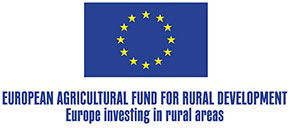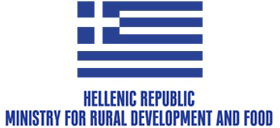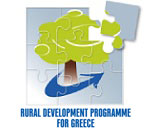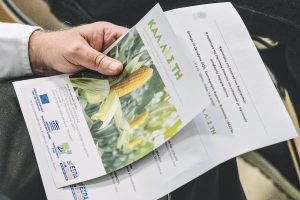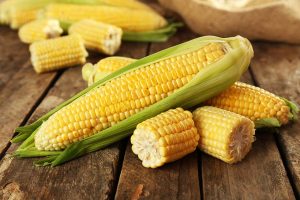Can we change the way we fertilise crops?

In conventional crop fertilisation, fertiliser is uniformly applied in the field, with the amount of fertiliser usually determined based on the yield of the sections with the lowest yield. Fertile sections of the field often receive more fertiliser than required, and each field receives the same amounts of fertiliser for the same crop each year, regardless of the weather conditions and when it is applied. All of the above contribute to reduced uptake of the applied fertiliser by crops, which can go as low as 30%, with very significant economic and environmental repercussions.
In recent years, the Institute of Industrial and Forage Crops – in collaboration with the Goulandris Natural History Museum and researcher Dr. Stamatis Stamatiadis – has been studying variable nitrogen supply to fields through multiple field experiments under real conditions, in order to increase the efficiency of nitrogen fertilisation. In collaboration with Dr. James Schepers, professor at the University of Nebraska in the USA, active multispectral foliar sensors were used to identify plants’ different nitrogen needs and apply appropriate fertiliser doses depending on actual plant needs, which vary both spatially within the same field and over time from year to year.
The active multispectral foliage sensors produce adjustable radiation in the visible (VIS, 400-700-nm) and infrared (NIR, 700-1,000-nm) electromagnetic spectrum ranges. They generate their own radiation in a way that makes it completely discernible from natural light, enabling them to be used at any time during the day (even during the night) and in any lighting conditions (clouds, fog, etc.).
Part of the radiation emitted by the sensors is absorbed by the foliage of the crop, and the rest is reflected. The radiation reflected by the foliage of the crop can be measured and quantified into various indicators. After many years of experiments in the USA, in 2010 Dr. Schepers’ research team created an algorithm that converts the reflectance measurements of the corn foliage carried out by active sensors into nitrogen fertilisation doses relative to soilological and other data. The amount of nitrogen calculated by the algorithms for a specific point in the field depends not only on foliar reflection indices, such as the NDVI chlorophyll index, but also on the stage of development of the crop at that point in time, the total amount of nitrogen required by the crop, and the amount of nitrogen already applied.
In this way, the information for assessing the nitrogen requirements is not based on soil analyses or plant tissue analyses, but on the reaction of the plant itself to the incident radiation, which includes any differentiations both spatially within a field and year to year. An important advantage of the method is that the behaviour of the plant in absorbing/reflecting the radiation received from the sensors incorporates all soil and climatic factors that affect its final yield.
Initially, from 2010 to 2012, the new surface nitrogen fertilisation method was used in cotton cultivation in the “HydroSense” project, which was co-funded by the European Commission through the LIFE+ environment programme. In HydroSense, prior to sowing, Management Zones (MZs) were created in the fields, using the multispectral sensors that map the reflection of the near-infrared spectrum of the bare ground. Surface nitrogen fertilisation was applied to each MZ in a differentiated manner, using the algorithm generated by Dr Schepers’ research team to estimate the optimal dose. The nitrogen reduction achieved was on average 35%, without reducing the final yields on the six pilot fields of the project, while the nitrogen fertilisation efficiency, compared to conventional, increased from 65% to 98%.
The low construction cost of the KAL.LI.S.TI system makes it ideal for small- and medium-scale applications, such as those of Greece
Further developing previous management, in the European “FATIMA” HORIZON 2020 project, on winter wheat, cotton and maize crops, the same algorithm was used in an innovative and automated variable nitrogen supply system, which applies the appropriate amounts of granular fertiliser in real time. In other words, the fertilisation of the crop takes place at the same time as the sensors scan the plants. The efficiency of surface nitrogen fertilisation compared to conventional fertilisation, as assessed in field experiments under real cultivation conditions, increased from 25% to 31% on all three crops, while reductions in nitrogen fertilisers were on average 38%, 31% and 35% for cotton, maize and wheat, respectively, without any reduction in yields.

Innovative surface fertilisation system
For the past two years – as part of the “Site-specific fertilisation in maize with variable nitrogen supply technology at high spatial resolution –KAL.LI.S.TI” project – the experience of the FATIMA project has been used in a new, original system of variable liquid nitrogen supply for the surface fertilisation of maize. Using the producer’s spray tank to store liquid nitrogen, the innovative system applies differentiated amounts of nitrogen at a high-discretion capability of 1m, in real time, at the same time as the sensors “scan” the crop. The low construction cost of the system makes it ideal for small- and medium-scale applications, such as those of Greece. KAL.LI.S.TI is introducing an internationally innovative technology that enables producers to conveniently and economically distance themselves from uniform fertilisation, opting instead for methods that better capitalise on soil fertility and provide in-field site-specific nutrient balance.
The results of the first year of application of differentiated fertilisation show a reduction of nitrogen by an average of 30% compared to conventional uniform fertilisation in the three pilot fields, with an average reduction of nitrogen fertilisation costs by 9 euros/1,000 m2. KAL.LI.S.TI’s variable nitrogen supply succeeded in approaching the economically optimal nitrogen dose in the fields, with significant economic and environmental benefits.
The Goulandris Natural History Museum, ELGO-DIMITRA’s Institute of Industrial and Forage Crops, the ‘THESGI’ Farmers’ Cooperative of Thessaly, GAIA EPICHEIREIN, and PRO DEPOT participated in the project. More information about the KAL.LI.S.TI project is available at: https://kallisti-og.gr/
The Project is being implemented in the context of Measure 16 Cooperation, SUB-MEASURE 16.1 – 16.5 “COOPERATION ON ENVIRONMENTAL PROJECTS, ENVIRONMENTAL PRACTICES AND ACTIONS FOR CLIMATE CHANGE” ACTION 2: “Implementation of the Operational Plan (project) of collaborations in order to promote actions that demonstrate respect for environmental protection and adaptation to climate change.”
Eleftherios Evangelou, agronomist/PhD in Soil Science, executive researcher at the Institute of Industrial & Forage Crops – ELGO “Dimitra”
